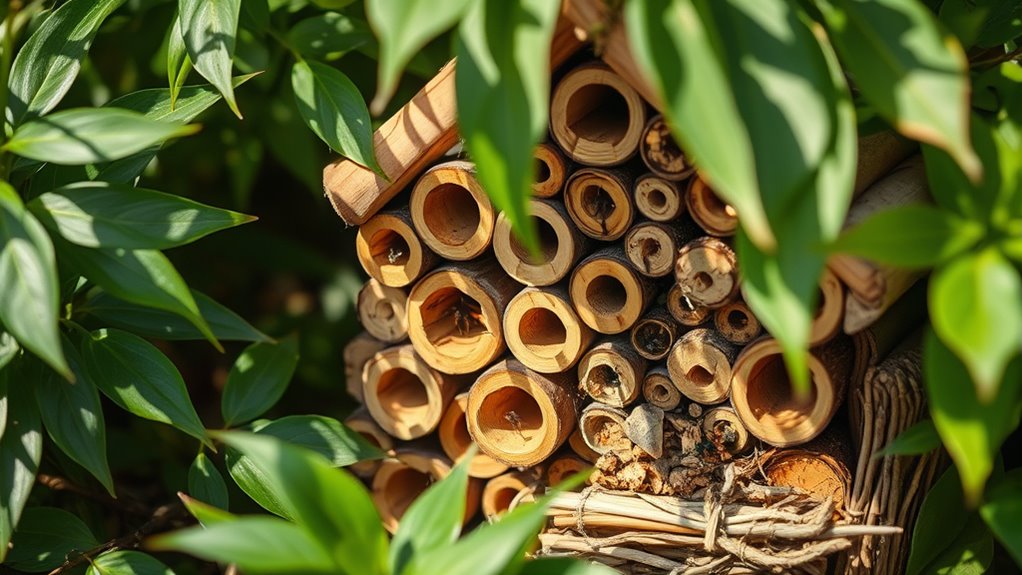Building a bug hotel with natural, native materials helps boost your garden’s biodiversity by providing essential habitats for beneficial insects like bees, ladybugs, and predatory wasps. Use materials such as hollow bamboo, bundled sticks, or drilled wood blocks, and place the hotel in a sunny, sheltered spot off the ground. By attracting helpful insects, you’ll naturally control pests and support pollination. Keep exploring to discover more tips on creating a thriving, balanced garden ecosystem.
Key Takeaways
- Incorporate native plants to attract and sustain beneficial insects, enhancing garden biodiversity and pest control.
- Use natural, biodegradable materials like bamboo and drilled wood to mimic insects’ natural nesting sites.
- Position the bug hotel in a sunny, sheltered location facing south or southeast for optimal insect activity.
- Avoid chemicals and pesticides to create a healthy environment supporting diverse beneficial insect populations.
- Design your bug hotel with varied cavity sizes and sections to host multiple beneficial insect species.

Have you ever wondered how to create a nesting haven for beneficial insects in your garden? Building a bug hotel is a fantastic way to attract these helpful creatures, and it starts with understanding the importance of native plants. Native plants are the backbone of a healthy garden ecosystem because they provide the natural food and habitat that local insects rely on. By planting native species around your bug hotel, you create an inviting environment that encourages beneficial insects like solitary bees, ladybugs, and predatory wasps to settle in. These insects play a crucial role in pest control; they naturally reduce the number of pest insects that threaten your plants without the need for chemical interventions. Incorporating native plants into your garden design makes it easier for beneficial insects to find food and shelter, increasing their presence and effectiveness in controlling pests. Additionally, selecting native plants can enhance the biodiversity of your garden, making it more resilient to pests and environmental stresses.
When constructing your bug hotel, consider the materials and placement carefully. Use natural, biodegradable materials such as hollow bamboo, bundled sticks, or wood blocks with drilled holes, which mimic the insects’ natural nesting sites. Position your bug hotel in a sunny, sheltered spot, ideally facing south or southeast, to maximize warmth and visibility. Keep it off the ground to prevent moisture build-up and decay, which can deter insects or lead to mold growth. As you build, think about making different sections with varied sizes of holes or cavities to accommodate various species. This diversity ensures a broader range of beneficial insects will find your hotel inviting and suitable for nesting.
In addition to the structure itself, fostering a healthy garden environment enhances the bug hotel’s success. Avoid using pesticides or chemicals that could harm the insects you want to attract. Instead, focus on nurturing native plants, which support local insect populations and promote biodiversity. A garden rich in native plants naturally attracts pollinators and predatory insects, reinforcing your pest control efforts. This ecological approach not only benefits your plants but also encourages a balanced, resilient garden ecosystem. As the beneficial insects establish themselves, they’ll help keep pest populations in check, reducing your reliance on chemical pest control methods. Recognizing the nutritional value of native plants can further support the health and diversity of your garden ecosystem.
Ultimately, creating a bug hotel that emphasizes native plants and provides suitable nesting sites helps you build a more sustainable garden. It transforms your space into a vibrant, biodiverse habitat, where beneficial insects thrive and work tirelessly to maintain plant health. By understanding the link between native plants and pest control, you’re investing in a natural, effective method to manage pests while supporting local biodiversity. Your garden becomes not just a place for growing plants, but a thriving ecosystem where every creature plays a vital role in maintaining balance.
Frequently Asked Questions
What Materials Are Safest for Bug Hotels?
When building bug hotels, you wanna use safe, natural materials like untreated wood, bamboo, bricks, and straw. Avoid chemicals or treated wood that could harm bugs. Incorporate native plants nearby to support the habitat and natural pest control. These materials provide cozy hiding spots and encourage biodiversity. By choosing safe, eco-friendly options, you help insects thrive, which benefits your garden’s health and pest control naturally.
How Do Bug Hotels Attract Specific Insect Species?
You can attract specific insect species by designing your bug hotel to promote habitat diversity, which appeals to native pollinators and other beneficial insects. Use varied materials and structures that mimic their natural environments, like hollow stems or bark. By providing diverse nesting options, you encourage targeted species to settle in your garden, supporting local ecosystems and helping native pollinators thrive naturally.
Can Bug Hotels Be Used Indoors?
Imagine inviting a tiny world of wonder into your home. While bug hotels are designed for outdoor use, you can adapt small, natural elements indoors for indoor planting and pest management. However, building a full bug hotel indoors isn’t practical or safe, as it might attract unwanted pests or mold. Focus on creating cozy, insect-friendly spaces that support beneficial bugs while keeping your indoor environment healthy and pest-free.
How Often Should a Bug Hotel Be Maintained?
You should check your bug hotel every few months to keep it in good shape. Follow a regular maintenance schedule to remove debris, replace worn materials, and guarantee proper airflow. This helps prevent pest management issues and keeps beneficial insects happy. If you notice pests or mold, address these problems promptly. Regular upkeep encourages biodiversity by providing a safe, inviting environment for bugs to thrive in your garden.
What Are the Environmental Benefits of Bug Hotels?
A bug hotel can revolutionize your garden’s ecosystem, offering incredible benefits. It promotes habitat diversity, creating safe spaces for beneficial insects that naturally control pests, reducing your reliance on chemicals. This tiny structure can be a game-changer, fostering a balanced environment where predatory bugs thrive. By supporting these natural pest control methods, you help protect pollinators and enhance your garden’s health, making it more resilient and vibrant.
Conclusion
Building a bug hotel isn’t just about providing shelter; it’s about planting a seed of hope and harmony in your garden’s ecosystem. Each carefully crafted nook becomes a symbol of your commitment to nature’s resilience, inviting life to flourish. As you nurture these tiny habitats, you’re cultivating a future where biodiversity thrives—reminding us that even the smallest actions can nurture a world of wonder, growth, and renewal. Your garden becomes a sanctuary for both bugs and the planet.











